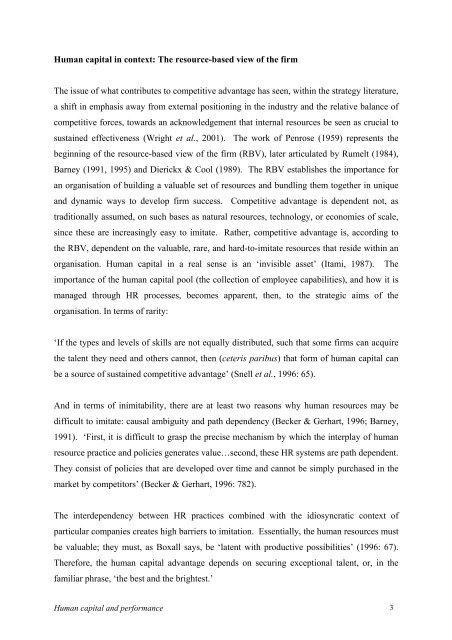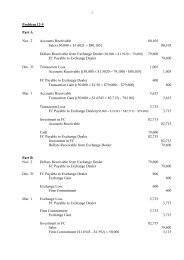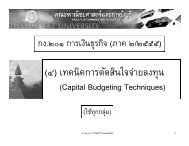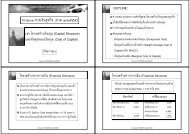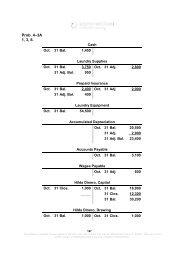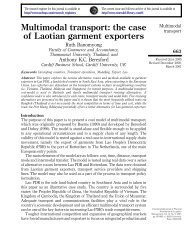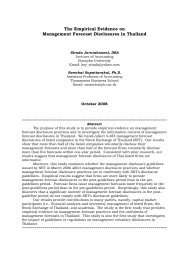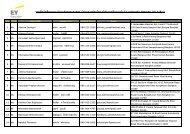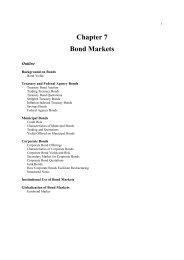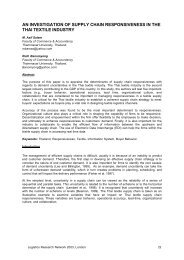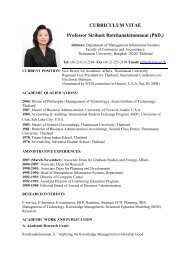Human capital and performance: A literature review
Human capital and performance: A literature review
Human capital and performance: A literature review
You also want an ePaper? Increase the reach of your titles
YUMPU automatically turns print PDFs into web optimized ePapers that Google loves.
<strong>Human</strong> <strong>capital</strong> in context: The resource-based view of the firm<br />
The issue of what contributes to competitive advantage has seen, within the strategy <strong>literature</strong>,<br />
a shift in emphasis away from external positioning in the industry <strong>and</strong> the relative balance of<br />
competitive forces, towards an acknowledgement that internal resources be seen as crucial to<br />
sustained effectiveness (Wright et al., 2001). The work of Penrose (1959) represents the<br />
beginning of the resource-based view of the firm (RBV), later articulated by Rumelt (1984),<br />
Barney (1991, 1995) <strong>and</strong> Dierickx & Cool (1989). The RBV establishes the importance for<br />
an organisation of building a valuable set of resources <strong>and</strong> bundling them together in unique<br />
<strong>and</strong> dynamic ways to develop firm success. Competitive advantage is dependent not, as<br />
traditionally assumed, on such bases as natural resources, technology, or economies of scale,<br />
since these are increasingly easy to imitate. Rather, competitive advantage is, according to<br />
the RBV, dependent on the valuable, rare, <strong>and</strong> hard-to-imitate resources that reside within an<br />
organisation. <strong>Human</strong> <strong>capital</strong> in a real sense is an ‘invisible asset’ (Itami, 1987). The<br />
importance of the human <strong>capital</strong> pool (the collection of employee capabilities), <strong>and</strong> how it is<br />
managed through HR processes, becomes apparent, then, to the strategic aims of the<br />
organisation. In terms of rarity:<br />
‘If the types <strong>and</strong> levels of skills are not equally distributed, such that some firms can acquire<br />
the talent they need <strong>and</strong> others cannot, then (ceteris paribus) that form of human <strong>capital</strong> can<br />
be a source of sustained competitive advantage’ (Snell et al., 1996: 65).<br />
And in terms of inimitability, there are at least two reasons why human resources may be<br />
difficult to imitate: causal ambiguity <strong>and</strong> path dependency (Becker & Gerhart, 1996; Barney,<br />
1991). ‘First, it is difficult to grasp the precise mechanism by which the interplay of human<br />
resource practice <strong>and</strong> policies generates value…second, these HR systems are path dependent.<br />
They consist of policies that are developed over time <strong>and</strong> cannot be simply purchased in the<br />
market by competitors’ (Becker & Gerhart, 1996: 782).<br />
The interdependency between HR practices combined with the idiosyncratic context of<br />
particular companies creates high barriers to imitation. Essentially, the human resources must<br />
be valuable; they must, as Boxall says, be ‘latent with productive possibilities’ (1996: 67).<br />
Therefore, the human <strong>capital</strong> advantage depends on securing exceptional talent, or, in the<br />
familiar phrase, ‘the best <strong>and</strong> the brightest.’<br />
<strong>Human</strong> <strong>capital</strong> <strong>and</strong> <strong>performance</strong> 3


